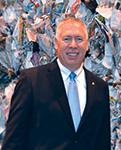From PFAS concerns and rising costs, to EPR legislation, growing AI, and changing industry perceptions, 2023 shaped up to be an interesting year and continued to gain attention on several issues.
Looking back on 2023, what are the significant changes you have seen over the past year in the waste and recycling industry?
 WILL FLOWER: There were considerable increases in operating costs in 2023 including transportation expenses, disposal costs, equipment, parts, and labor. Subsequently, waste managers had to adjust and pass those higher costs along to consumers with higher fees for waste management and recycling services to keep pace with the escalating operating costs. As anticipated, higher interest rates resulted in fewer housing starts and a reduction in construction and demolition, thereby effecting roll-off sales and C&D volumes.
WILL FLOWER: There were considerable increases in operating costs in 2023 including transportation expenses, disposal costs, equipment, parts, and labor. Subsequently, waste managers had to adjust and pass those higher costs along to consumers with higher fees for waste management and recycling services to keep pace with the escalating operating costs. As anticipated, higher interest rates resulted in fewer housing starts and a reduction in construction and demolition, thereby effecting roll-off sales and C&D volumes.
 MARC ROGOFF: Not unlike other years, pricing for recyclables collected curbside remains volatile based on revenues received by our clients from both domestic and international markets. Paper products are going up, but plastics such as PET, HDPE, and poly polypropylene continue to be down in 2023. Further, some industry observers have opined that the U.S. is in a “carboard box recession”, suggesting that manufacturing is in a global recession because demand for cardboard linerboard has fallen in 2023. It is hard to predict if these trends will continue in 2024, although I’m personally optimistic that the economy will take off in the new year with the Federal Reserve expected to lower interest rates by mid-year.
MARC ROGOFF: Not unlike other years, pricing for recyclables collected curbside remains volatile based on revenues received by our clients from both domestic and international markets. Paper products are going up, but plastics such as PET, HDPE, and poly polypropylene continue to be down in 2023. Further, some industry observers have opined that the U.S. is in a “carboard box recession”, suggesting that manufacturing is in a global recession because demand for cardboard linerboard has fallen in 2023. It is hard to predict if these trends will continue in 2024, although I’m personally optimistic that the economy will take off in the new year with the Federal Reserve expected to lower interest rates by mid-year.
One of the biggest reports in recycling has been the continued number of stories in the press suggesting that recycling is a “sham.” This has resulted in many Americans being convinced that they should not waste their time in recycling plastics since these materials are not recycled. Several communities in my “neck of the woods” have dropped curbside recycling, suggesting that it is not worth their citizens’ time to recycle given the paltry revenues received. To this observer, these efforts have harmed some very good recycling programs.
In late 2023, Delta Airlines announced a program that it was using paper cups for all liquids served in flight. The announcement indicated that facilities for recycling of paper cups were available at most airports. Since paper cups are heavier than plastic, it is hard to believe that this will result in any reduction in recycling tonnage.
Organics continue to gain attention both on the local and national levels. However, nothing has changed since I entered the solid waste industry some 40 years ago. There are continuing issues with odors at some locations not following best management practices and the markets for the recovered compost. The industry is littered with failed projects and oftentimes unachievable targets.
 DAVID BIDERMAN: I do not think 2023 was a year filled with significant changes for the waste and recycling industry. I believe it was the first true “post-COVID” year and that the industry largely continued to do an excellent job collecting and managing waste and recyclables. There have been several significant investments in RNG by various companies, and Republic’s new Polymer Center in Las Vegas, NV likely heralds additional investments in downstream recycling solutions.
DAVID BIDERMAN: I do not think 2023 was a year filled with significant changes for the waste and recycling industry. I believe it was the first true “post-COVID” year and that the industry largely continued to do an excellent job collecting and managing waste and recyclables. There have been several significant investments in RNG by various companies, and Republic’s new Polymer Center in Las Vegas, NV likely heralds additional investments in downstream recycling solutions.
 BRYAN STALEY: The past year witnessed a growing mainstream emphasis on quantifying circularity and sustainability with the understanding that these concepts rely substantially on waste and recycling. This is a concept that is becoming more mainstream with executive leadership in the waste companies. There has been an increased focus on emissions, recycling, and EPR activity highlighted by EPA grants in these areas.
BRYAN STALEY: The past year witnessed a growing mainstream emphasis on quantifying circularity and sustainability with the understanding that these concepts rely substantially on waste and recycling. This is a concept that is becoming more mainstream with executive leadership in the waste companies. There has been an increased focus on emissions, recycling, and EPR activity highlighted by EPA grants in these areas.
Investment trends shifted as well, with solid waste management becoming a more integral part of ESG portfolios, potentially affecting the stock prices of publicly traded waste companies, as exemplified by the elevated temperature landfill situation that temporarily impacted Waste Connections’ stock.
What kinds of concerns and challenges in the waste and recycling industry are happening currently and how can they be addressed? What other trends do you foresee causing a shift in dynamics?
 PAUL ROSS: There has been a noticeable increase in fire incidents. The risk of fires in recycling facilities is particularly high due to the presence of flammable materials, leading to rapid spread and potential re-ignition. Fire incidents not only cause delays and harm to facilities, but it also affects recycling markets by putting a halt to the production of recycling materials to particular markets. We suffered our own MRF fire in 2021 and have since recovered, but it put a major squeeze on the recycling markets in the entire state of Oklahoma.
PAUL ROSS: There has been a noticeable increase in fire incidents. The risk of fires in recycling facilities is particularly high due to the presence of flammable materials, leading to rapid spread and potential re-ignition. Fire incidents not only cause delays and harm to facilities, but it also affects recycling markets by putting a halt to the production of recycling materials to particular markets. We suffered our own MRF fire in 2021 and have since recovered, but it put a major squeeze on the recycling markets in the entire state of Oklahoma.
Lithium-ion batteries are a major fire risk, accounting for about 50 percent of fires at facilities. The rapid growth of lithium-ion batteries in the market is expected to further increase fire incidents at waste and recycling facilities. Despite the rising number of fires, there is a lack of specific regulations. I am hopeful the future might lead to better regulations in this area.
 SEAN JENNINGS: Costs continue to increase for all items, but risk and insurance related costs have stood out in the second half of the year. This may make it very difficult for certain organizations to compete financially if they do not adapt and improve safety results.
SEAN JENNINGS: Costs continue to increase for all items, but risk and insurance related costs have stood out in the second half of the year. This may make it very difficult for certain organizations to compete financially if they do not adapt and improve safety results.
WF: The cost of providing services continues to increase. Successful companies will be those who adjust and remain focused on mitigating rising costs by pushing prices. Other concerns for the year ahead include fires at facilities caused by lithium-ion batteries, labor shortages, and low commodity prices for some recyclables. Of course, there is a never-ending concern over the adoption of bad legislation that occurs when the industry is not actively involved in the decision making process. On the bright side, advancements and the implementation of new technologies continues to make the industry efficient and viable. We are seeing remarkable gains in efficiency from routing software, the application of artificial intelligence, improved sorting equipment, and better communication with customers.
DB: I think the potential Surfund liability that both local governments and solid waste companies may have in connection with PFAS in leachate could be a major challenge. EPA is expected to finalize and issue regulations by mid-2024 identifying certain PFAS compounds as hazardous substances under Superfund. Landfills, including those that have been closed for decades, that sent leachate to wastewater treatment facilities could be on the hook for millions of dollars in remediation costs. At a minimum, many lawyers will get rich off this new EPA rule. The industry has sought an exemption from Congress and has gotten a bill (S. 1429) introduced that would provide a liability exclusion, but I am not confident this bill becomes law in 2024.
A second major and ongoing challenge continues to be safety. Solid waste employees, trucks, and heavy equipment continue to be involved in too many incidents, including injuries and third-party claims. Many companies experienced an increase in frequency in 2023. The majority of the exposure is in collection, where employees work in the 7th most dangerous occupation in the U.S. Many larger companies and sanitation departments have robust safety programs with education and training, but some smaller employers lack high-quality safety training that can reduce collisions and injuries. I have been providing training to a growing number of companies and local governments, with a focus on persuading drivers and helpers to change their unsafe behaviors that can contribute to incidents.
BS: There are a number of technical and operational challenges we track at EREF. Key issues include emissions measurement for detection, mitigation, and policymaking, the reemergence of elevated temperature landfills, persistent problems like MRF fires and PFAS, and the novel ‘black goo’ problem in landfills. Policy and regulation development often precede a full understanding of operational science, raising concerns about premature implementation, especially in emissions technology. EREF continues to provide accurate and complete science for decision-makers to minimize any “cart before the horse” actions like implementing new technology without fundamentally understanding the need.
As waste management and recycling has continued to evolve, especially with regards to automation, do you believe that more organizations will make the transition within the next few years? How do you think ChatGPT and AI will affect the industry?
WF: AI is having an impact for all businesses, including the waste and recycling industry. Specific areas where AI are helping the industry include customer service and support, marketing, relationship management, data management, and analysis. There appears to be a great deal of upside for AI contributing to better customer support and service. At the same time, the barriers to AI applications in waste and recycling will be the significant capital costs and attracting skilled employees that will be needed to manage and interpret all the data associated with AI systems. On the equipment and software side, we will continue to see the increased deployment of optical sorting and robotics at recycling centers for the remainder of the decade.
DB: I think ChatGPT has limited utility for frontline solid waste collection, processing, and disposal operations. As AI evolves and can be used for various tasks, including identifying dangerous inbound materials or contamination at transfer stations and MRFs, it will be used by more companies and local governments.
PR: Automation, robotics, and AI technology will continue to enhance the industry. However, the effectiveness of AI and robotics is contingent on the quality of programming. The development of electric vehicles in the industry is ongoing, and while it might take some time before widespread adoption, the future looks promising with continuous innovation.
BS: Automation is increasingly prevalent across the waste management chain, particularly in areas like MRF picking lines and for fire detection and suppression, continuing to increase efficiency and reduce risks at recycling facilities. The integration of electric vehicles (EVs) faces challenges due to range limitations and vehicle weight and efficiency. Their adoption is likely going to be more region-specific rather than national in the near term. Hydrogen fuel is a potential alternative, but there are still lots of questions on alternative fuels. AI-driven systems are expected to enhance efficiencies to allow for real-time detection and decision making (e.g., anaerobic digestion systems, managing, and monitoring controls). ChatGPT’s role remains uncertain, particularly in media and reporting due to potential inconsistencies and inaccuracies without proper fact-checking.
SJ: I don’t believe that Chatbots will have a significant effect on the industry beyond a way to handle customer service inquiries, but certainly would not be a replacement. We believe that there will be further improvements in manual process automation like recyclable sorting, but the most significant impact that AI and other technology improvements will have will be regarding safety. We are looking forward to better tools to reduce accident and injuries. Due to the rising costs associated with accidents and injuries, other organizations will be forced to improve or will not be competitive.
MR: The use of EVs has been widely talked about in recent years for waste collection. Some municipalities and private sector providers have been on the leading edge for adoption of this technology. These “early adopters” will provide good information and data on the good, the bad, and the ugly aspects of this technology, including costs, maintenance, and charging systems. However, the ramp up appears to be focused on the length of time from award to final delivery. Some MRFs have been already retrofitted with robotics to improve sorting capability, reduce contamination, and reduce manpower requirements. I would expect that this trend will continue into 2024.
Changing people’s perceptions of how the waste and recycling industry is viewed continues to be a top priority for many companies and organizations, how have you transitioned your messaging over the past five years?
WF: Successful companies are those who are transparent with the communities and customers they serve. This industry does a lot to help customers and municipalities. We create innovative programs that are sustainable and cost effective. We invest millions of dollars to improve and strengthen waste and recycling systems. We must be loud and proud when it comes to ‘telling our story’ about the good work that we do on a daily basis. This past year, Winters Brothers published a “State of Waste” report to explain the current issues facing society and the management of solid waste on Long Island (NY). We also went a step further by making 14 recommendations to address solid waste and sustainability issues. In the report, we talked in layman’s terms about the issues, challenges opportunities and, most importantly, talked about the challenges, and provided realistic recommendations to improve the situation. As an industry, we should to be aggressive and honest in telling people what is needed to improve solid waste systems. After all, who knows better than we do, what is needed to improve the management of society’s waste?
BS: Educational efforts have been key in changing perceptions, highlighting the nuanced nature of waste management decisions. A great example is the choice between paper or plastic bags, which depends on local recycling capabilities and landfill gas collection practices. For those who are trying to make sustainable decisions, educating them on their local waste management capabilities are paramount. In general, a better-informed public will lead to a more nuanced understanding and balanced viewpoint of the waste management industry.
PR: Shifting the view of these professionals from unskilled to skilled and specialized workers is a strategic approach to recruitment, hiring, and promotion. This shift is vital for evolving public perception of the industry in the United States.
Considering the safety trends from 2022/2023, do you believe safety has improved in certain areas of the industry? How can companies continue to improve safety standards?
DB: I think that the industry’s safety record needs to continue to improve. Many drivers and helpers are either unaware of the ANSI Z245.1 safety standards or are being told that productivity is more important than safety. Companies and municipal sanitation departments need to prioritize improving their safety culture through management commitment, employee participation, training, and positive communications.
BS: Safety remains a major focus. EREF is launching a collaboration with NWRA to better understand fatalities in the industry so that existing safety and best management practices can be validated or revised, and potential new practices developed. This will add more granularity to some of the safety challenges that have historically faced the industry, particularly fatalities. EREF is working with an academic partner to analyze data over the past number of years on fatalities to produce better information that, ideally, can be used by companies to improve safety standards.
WF: I think facilities are getting safer mostly due to automation and advancements in ergonomics and engineering. Safety must be the number one priority of every single company. A good safety program requires a commitment throughout the entire organization. It is a lot of work and it requires an investment of both money and time. However, the ROI on safety is worth every penny and every minute. Good safety programs focus on the basics—education, training, worksite evaluations, field observations, coaching, accountability, and, most importantly, building and reinforcing a culture of safety.
SJ: I believe that safety has improved in every area of the industry. The amount of seasoned, professional drivers is declining each year, and the companies must adapt by providing better assessment and training. Expectations from an occupation are constantly evolving and de-risking and we will continue to see that push the waste industry to more automation and less hours worked. The constant, increasing claim expense risk will also push companies to invest more in de-risking. Companies will invest more into on board accident-avoidance technology, on-board coaching tools, automation, flexible schedules, and leadership and communication improvement.
PR: It is encouraging to hear that safety has improved and standards are at an all-time high. Continuing to foster a deep-rooted safety culture within the industry is crucial for further improvements. The focus should be on ingraining safety practices into the everyday behavior and mindset of workers at all levels. Like we say at American Waste Control: “Safety has to be more than mandated—it has to be who we are.” It is ingrained into our company culture.
What does the landscape of Mergers & Acquisitions look like? Years ago, it was very active,but seems to have stabilized. Do you think that we will see a lot of activity in 2024?
WF: Over the past three years, we have witnessed an increase in mergers and acquisitions activities. The waste sector continues to be an attractive investment especially for infrastructure funds and companies looking for opportunities to leverage economies of scale and cost reduction. Keep in mind, the waste and recycling industry is made up of thousands of companies providing a basic, essential service with strong and predicable cash flows. As a result, the sector is suitable for consolidation. Bottom line: there is a lot of room for more deals.
SJ: From our perspective, there are still many acquisition candidates and would expect a few larger deals to take place in 2024. Rising interest rates do not seem to have significantly affected valuations, likely due to there being less candidates than in the past. There may be more acquisition candidates for some of the public companies as they have expanded their services offered.
PR: 2023 was still an active year, with the larger companies spending more than $2 to $3 billion in M&A, but there was also a particular increase in activity from smaller, private equity-backed players. This is a concern for me because to me the waste and recycling industry is a people-backed industry and sometimes it feels like Wall Street or private equity may forget that.
DB: Although making predictions about future M&A is often a fool’s errand, I suspect that the recent stabilization of transactional activity will likely continue into 2024. I believe that some of the larger acquirers will spend 2024 digesting recent purchases, although they will continue to be opportunistic if quality companies and assets become available. I think we will continue to see increased private equity investments in mid-market players in 2024.
MR: In general, the trend towards larger companies in the solid waste industry continues unabated. Relatively “cheaper money” in the Great Recession Era, allowed companies to borrow extensively to merge and acquire new assets. This changed in the Pandemic Era with inflation increasing and the Federal Reserve increase borrowing rates.
Geosyntec followed the solid waste M&A market closely and has gained perspective from our participation, having provided advisory and due diligence services for more than 20 years. The solid waste M&A landscape was healthy in 2023 and we expect 2024 to be somewhat stronger. Neither year will match the exceptional results of 2022.
During 2023 there were approximately 110 announced transactions with an estimated value of $4 to $5 billion; overall, similar to 2021 results (~120 deals). Buyers included PE or PE backed companies (~50 percent of deals), of course, large publicly traded companies (30 percent) and the balance private companies. Acquisition target companies were primarily in collection (~70 percent), but otherwise diverse and included disposal, MRF’s, organics, liquid waste, and software companies, among others.
Factors fueling the M&A market for buyers were strong capitalization, availability of targets, good waste management business fundamentals, a resilient economy, and infrastructure and tax legislation. Sellers were motivated by good (but not peak) valuations, financial planning/retirement considerations, mixed economic outlook, high cost of capital high, improved by continued issues with supply chain and labor supply and costs.
BS: While not EREF’s area of specialty, I can make some general statements. The M&A landscape appears to have reached a more stable phase. This trend is partially attributed to several over-leveraged companies deliberately slowing down their M&A activities as a strategic move to reduce their leverage.
Additionally, larger M&A activity (aka, assets under one company’s umbrella) in recent years has predominantly involved larger mid-size companies, leading to a current market dominated by smaller mid-sized entities. These smaller companies are progressively growing and are likely to evolve into larger mid-size businesses. This growth trajectory might be one of the reasons behind the observed slowdown in M&A activity, along with the ongoing de-leveraging efforts.
Looking ahead to 2024, the pace of mergers and acquisitions is anticipated to mirror the patterns seen in 2023, at least during the early to mid-part of the year. However, this forecast is subject to change based on economic shifts and developments anticipated in the spring of 2024, which could potentially influence the M&A landscape.
What do you think regulations will look like in 2024, especially with regards to EPR/packaging laws, PFAS, funding, recycling and organics?
MR: There was a considerable number of federal and state regulations that were promulgated in 2023. For example, California finalized a road map to zero emission fleets and lawmakers enacted a right-to-repair law for recyclables. There are now 30 states that have introduced right-to-repair legislation in 2023. Further, New York City issued a new law requiring curbside organics recycling service, but this has been delayed by city-wide budget cuts of $32 million, This will result in a delay in the rollout of curbside organics programs in the Bronx and Staten Island boroughs of the city.
Over the last few years, there has been important congressional bills that have been enacted and now part of EPA’s grant funding process for solid waste and recycling. EPA is currently in its grant awards process, which so far as of this writing, totals more than 133 million dollars for recycling infrastructure, environmental justice initiatives, and education/outreach.
The EPA released interim guidance in 2021 on destroying and disposing of certain PFAS and PFOS and containing materials that are not consumer products. The guidance for these “forever chemicals” outlines the current state of the science on techniques and treatments that may be used to destroy or dispose of PFAS and PFAS-containing materials from non-consumer products, including aqueous film-forming foam (for firefighting). The guidance was available for public comment until February 22, 2021, and the comment period is now closed. The EPA issued a final rule for minimum reporting levels and lifetime health advisory levels (parts per million). Some states such as California and Michigan have issued some guidance.
In general, landfill operators have issued a notice to EPA citing significant liability under the Environmental Response, Compensation, and Liability Act, commonly known as the Superfund law, with these rules, requesting a targeted exemption.
DB: On the federal level, EPA will be issuing regulations on PFAS and other issues affecting the industry. I expect lawsuits will be filed challenging EPA’s designation of certain PFAS compounds as hazardous substances under Superfund, which could delay implementation. EPA will also distribute a second round of recycling grants late this year. At the state level, I expect several states to continue to push forward on EPR/packaging laws and others to consider additional legislation concerning diverting organics away from landfills.
BS: I think PFAS conversations will be more active in the spring as Congress comes back into session. EPR has been an active area and will continue to be as it is still a policy focus on many state and local levels. The big issue on the solid waste side, and one EREF continues to research, is what does PFAS mean for waste management? For example, there are lots of composting operations that are becoming much more sensitive to PFAS and could restrict their acceptance of PFAS containing waste materials. That will potentially be an interesting trend for what happens to organics and whether composting operations will accept organics that contain PFAS. If not, those materials are likely destined for a landfill. Emissions are also a factor, with specific measurement technologies being a significant topic of conversation at EPA.
PR: 2024 might see developments in EPR packaging laws, recycling, and organics. The key to regulation in 2024 is innovative solutions and problem-solving initiatives.
WF: We have seen an increase in legislation aimed at reducing waste and promoting sustainability, especially as it relates to packaging and organics. Unfortunately, we have also seen bad, ill-conceived legislation, which does more harm than good. For example, EPR programs are simply not working and have done nothing more than raise the cost of recycling without improving recycling rates. A much better approach would be to pass legislation to “Close the loop.” States should adopt laws that require any unit of government which establishes a waste diversion goal, must also establish a use policy that matches or exceeds the diversion goal. Such laws would properly balance diversion and markets for recycled materials.
What do you think that 2024 will hold for the industry?
SJ: For the most part, it will be more of the same with increasing consolidation, prices, and valuations.
WF: Like most years, it will be a mixed bag. On the negative side, we will see more and more fires in collection trucks, transfer stations, recycling centers, and disposal sites due to lithium-ion batteries entering the waste stream. Government has failed to act, and the lack of action is threatening a vital infrastructure. We need to force the battery industry to act and address the growing risk of improper disposal of lithium-ion batteries that are threatening our people, and destroying our trucks, and facilities. We will also see states and the EPA advance programs on per-and polyfluoroalkyl substances, which could affect disposal operations. On the bright side, the industry is healthy, the economy is strong, and there is a lot of attention on sustainability, recycling, and solid waste issues. As a result, there is an opportunity and, indeed, an obligation for the people of this industry to step up and be thought leaders and strong advocates at the state and federal levels to actively promote and shape laws, rules, and regulations that protect and preserve the environment while strengthening our industry.
DB: The solid waste and recycling industry’s overall success is largely based on economic growth. The Biden Administration and Federal Reserve appear to have been able to foster economic growth and raise interest rates to reduce inflation and cool off the overheated post-pandemic economy, without plunging the country into a recession. Most economists in early 2023 were predicting a recession. In early 2024, many economists are predicting continued economic growth in the 2 to 3 percent range and mild inflation. The Federal Reserve is expected to start reducing interest rates in a few months. These developments would be positive for the industry.
MR: In short, I think 2024 will be a good year for solid waste given the positive economic news. However, safety continues to be a major negative for the industry. Waste collection continues to be the 7th deadliest job based on the Bureau of Labor Statistics data released in 2022. The ranking did not go down from the previous year suggesting that additional efforts by public and private operators continues to be challenging for an industry that employs well over 500,000 people.
There have been a few ambitious bills that have been introduced in Congress during the current session that aim to reduce plastic waste such as EPR, nationwide beverage refunds, and banning single-use plastics. It appears unlikely that these bills will pass a divided Congress in 2024.
Lastly, there has been some major coverage in Florida in the news media about fires in garbage trucks from “lithium-ion batteries”. These batteries are found in all sorts of electronics that are now being disposed in the trash. It is a severe problem with “hot loads.” The industry needs to do a better job in educating citizens about the disposal of these materials.
BS: 2024 is poised to bring continued challenges and developments in the waste management industry. A significant issue is the ongoing backlog in new garbage truck orders. Many companies face delays in refreshing their fleets—a trend that is likely to persist into 2024.
The focus on PFAS will remain prominent. Landfill owners are likely to be more aggressive at managing and estimating emissions, a response not only to internal sustainability goals, but also due to the heightened scrutiny from environmental groups. These groups are employing satellite technology to monitor not only landfills, but also other industries like oil, gas, and agriculture.
There will be a greater emphasis on identifying and managing fire-causing materials within the waste stream, particularly in the waste collection and recycling processes. The handling and detection of hazardous materials, such as lithium-ion batteries, will be a key focus area, with efforts directed towards early detection and better management of these materials before they enter waste processing facilities.
Another significant trend will be the increased integration of product manufacturers into discussions about waste management, particularly around themes of circularity and sustainability. There’s a growing realization that waste management outcomes are heavily influenced by product design and packaging choices made by manufacturers. This aspect is crucial in determining how consumers dispose of these materials. The dialogue around these issues is expected to intensify, fostering more collaborative efforts between waste management entities and product manufacturers to achieve more sustainable waste management and recycling practices.| WA
THANK YOU TO OUR EDITORIAL ADVISORY BOARD PARTICIPANTS!

David Biderman is the President of Biderman Consulting, LLC in Fairfax, VA, and the former Executive Director of SWANA. He can be reached at [email protected].

Marc Rogoff, Ph.D., is Senior Consultant for Geosyntec Consultants. He can be reached at (813) 810-5547 or e-mail [email protected].

Will Flower is Senior Vice President for Winters Bros. Waste Systems. He can be reached at (516) 725-1105 or e-mail [email protected]

Sean Jennings is President and CEO of Waste Pro. He can be reached at (407) 718-7400 or e-mail [email protected].

Paul Rossis Vice President of American Waste Control. He can be reached at (918) 446-0023 or e-mail [email protected].

Dr. Bryan Staley is President and CEO of the Environmental Research & Educational Foundation (EREF). He can be reached at [email protected].
